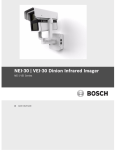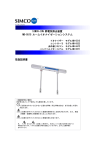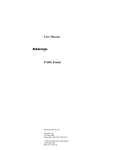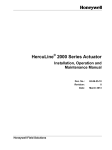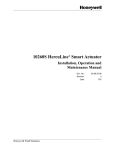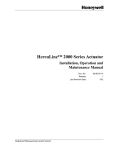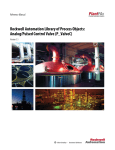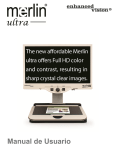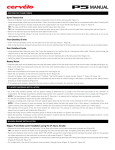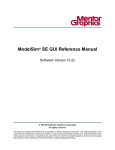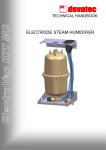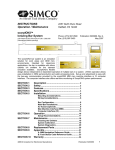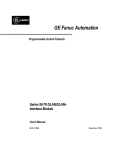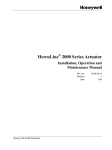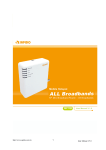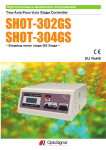Download IONIZATION SOLUTIONS Digital AeroBar®
Transcript
IONIZATION SOLUTIONS Digital AeroBar® Ionization System Model 5225S User’s Manual About Simco-Ion Simco-Ion develops, manufactures, and markets system solutions to manage electrostatic charge. As the world's largest provider of electrostatics management products and services, Simco-Ion improves its customers' business results by providing a total solution to their electrostatic discharge and electromagnetic interference challenges. Simco-Ion is a division of Illinois Tool Works (ITW) with its Technology Group located in Alameda, California. For more information about Simco-Ion visit www.simcoion.com or call 800-367-2452. Simco-Ion is ISO 9001 and ANSI ESD S20.20 certified. © 2012 Simco-Ion 19-5225S-M-01 Rev 2 Important Safety Information Failure to follow these important safety cautions could result in damage to Digital AeroBar System components and voiding of your system warranty. Use proper input voltage to avoid damaging the unit. Never power-down an AeroBar by removing the cables, as this can result in damage to the ionizer. Do not clean emitter points while unit is powered. Doing so may result in additional contamination and possible shock. To avoid personal injury or damage to the equipment, perform only the installation and maintenance procedures contained in this manual. Verify that the AeroBar is not powered before connecting or removing cables. Failure to do so may result in damage to the equipment. 19-5225S-M-01 Rev 2 Contents 1 Description ......................................................................... 1 1.1 Overview ................................................................................................. 2 1.2 Remote Control....................................................................................... 5 1.3 Power Requirements .............................................................................. 7 2 Installation .......................................................................... 9 2.1 Mounting ................................................................................................ 11 2.2 Wiring..................................................................................................... 13 2.3 FMS Connection ................................................................................... 17 2.4 Daisy-chaining ....................................................................................... 17 3 Operation ......................................................................... 19 3.1 About AeroBar Adjustments.................................................................. 20 3.2 Using the Remote Control..................................................................... 21 3.3 Ionization Mode (OpMode) ................................................................... 25 3.4 Output Voltages .................................................................................... 27 3.5 On- and Off-times (Pulsed DC Mode Only) .......................................... 28 3.6 FMS Alarm Values ................................................................................ 29 3.7 Balance Adjustment and System Calibration......................................... 31 4 Maintenance ..................................................................... 39 4.1 Maintenance Power Down .................................................................... 4.2 AeroBar Maintenance ........................................................................... 4.3 Remote Control Maintenance ............................................................... 4.4 System Adjustment & Calibration ......................................................... 40 41 45 46 5 Specifications................................................................... 48 5.1 AeroBar Model 5225S............................................................................ 49 5.2 Parts & Accessories............................................................................... 53 5.3 Dimensional Drawings ........................................................................... 53 6 Warranty & Service ........................................................... 56 19-5225S-M-01 Rev 2 1 Description 1.1 Overview 1.2 Remote Control 1.3 Power Requirements 19-5225S-M-01 Rev 2 1 1.1 Overview The Digital AeroBar Model 5225S is specifically designed for use in a variety of applications, ranging from inside tools to work stations and cleanroom areas where digital performance with easy integration is desired. The Model 5225S operates as a standalone system with internally maintained settings. Setup and adjustment are performed with the infrared Handheld Remote. The AeroBar Model 5225S is available in five standard lengths: • 22 inches (558 mm) • 28 inches (711 mm) • 44 inches (1118 mm) • 64 inches (1626 mm) • 84 inches (2134 mm) Three lengths are also available with optimized placement of emitter points over the FOUP openings for use in 300 mm EFEMs. • 36 inches (907 mm) • 56 inches (1412 mm) • 76 inches (1918 mm) 19-5225S-M-01 Rev 2 2 AeroBar Controls and Connectors Figure 1. AeroBar Model 5225S (Bar is longer than shown. The number of emitter points will vary per bar.) 1. Modular Port: A modular port on one end of the bar allows a RJ-11 connection to the 24 VAC power supply for the bar. 2. Emitter Points: Emitters points are replaceable. The number of points depend on the length of the bar. 3. Positive and Negative Ion Output Indicators: LEDs indicate high voltage (HV) ionization. In Pulsed DC mode, lights flash depending on which polarity has HV. Lights are continuously on when in Steady State mode. Both positive and negative ion indicators and the Alarm LED flash once simultaneously during communication. 4. Transmit and Receive LEDs: LEDs communicate with an optional IR remote control. 5. Alarm LED: LED flashes when the AeroBar is in alarm or standby mode; also flashes once during communication with the IR remote. Emitter Points 19-5225S-M-01 Rev 2 3 Emitter points are replaceable. The number of points depends on the length of the bar. Length of Bar in Inches No. of Emitter Points 22 5 28 7 36 (2-load port configuration) 8 44 9 56 (3-load port configuration) 12 64 13 76 (4-load port configuration) 16 84 17 Indicators Positive and Negative Ion Output Indicators These LEDs indicate high voltage (HV) ionization. In pulsed DC mode, the lights flash depending on which polarity has high voltage. Lights are continuously on when in steady state DC mode. Both of the positive and negative ion indicators and the alarm LED flash once simultaneously during communication. Transmit and Receive LEDs These LEDs indicate communication with the Remote Control. Alarm LED The red alarm LED flashes when the AeroBar is in alarm or standby mode; also flashes once during communication with the Remote Control. 19-5225S-M-01 Rev 2 4 1.2 Remote Control The Infrared Remote Control Model 5570 is used to communicate and set the power and timing parameters. Unlike a typical consumer remote control, the 5570 features a narrow infrared beam that prevents communication errors with nearby AeroBars. For best results, hold the remote control within 18-24 inches of an AeroBar’s vertical centerline and aim directly at the receive LED of the AeroBar. When the AeroBar receives transmission from the remote control, it will flash all three LEDs for one second. Each successive transmission is indicated with a one-second flash after the last received transmission. There are four buttons on the Remote Control 5570 (Up, Down, Select, and Esc). • The Up and Down buttons are used to scroll through menu items. • The Select button selects an item to be changed. • The Esc button wakes the remote control from sleep mode, or exits from the activity of a parameter being changed. Figure 2. Remote Control Buttons 19-5225S-M-01 Rev 2 5 Passwords The Remote Control features two levels of access: a User Menu level, and a Technical Field Service (TFS) menu. • The User Menu level allows you to view current AeroBar settings, change the operation mode, change the positive and negative output levels, and set the on times and off times. • The TFS Menu is password-protected and all basic and advanced parameters can be changed. Both the User Menu and TFS Menu feature two lines of information. The first line displays the item of the menu. The second line displays the current adjustment level or operation mode for that item. An on/off slide switch is featured on the right side of the remote control. Upon powerup, the 5570 remote control shows the following: UsrMenu Ver 2.6 Most menu items of the Remote Control require a password in order to be changed. The positive and negative output levels of an AeroBar can be changed without a password. The password is: Esc, Down, Up, Select, Select, Select, Select. Sleep Mode The Remote Control Model 5570 automatically goes into sleep mode if there is no button activity for 15 seconds. Press the Esc key to awaken the remote control. While in sleep mode, the LCD displays: Use ESC To Awake If the battery is low during sleep mode, the bottom line is replaced with LowBatt. 19-5225S-M-01 Rev 2 6 1.3 Power Requirements The AeroBar can be powered from any 24 VAC source using one of the following options: • Hard wire to a DIN rail mount transformer (p/n 14-21730) • Connect to DIN rail mount transformer through a junction box using an RJ-11 to RJ-11 interconnect cable (p/n 33-1700-xx) • Connect to a 100/115/230 VAC switchable desktop transformer (p/n 14-1535). 19-5225S-M-01 Rev 2 7 19-5225S-M-01 Rev 2 8 2 Installation 2.1 Mounting 2.2 Wiring 2.3 FMS Connection 2.4 Daisy-chaining 19-5225S-M-01 Rev 2 9 Important Safety Information Failure to follow these important safety cautions could result in damage to Digital AeroBar System components and voiding of your system warranty. Before installing or operating any components, carefully read the following safety information: After removing power from the AeroBar(s), allow a minute for the high voltage power supplies to discharge. Use proper input voltage to avoid damaging the unit. 19-5225S-M-01 Rev 2 10 2.1 Mounting General Guidelines Installation methods will vary, as all process equipment has different requirements. Use the following general guidelines: • Install AeroBars away from all moving components in the tool or environment. • Place AeroBars directly in the airflow from HEPA filters for effective ionization discharge. • Make sure that there are no obstructions in the airflow between the AeroBar and the surfaces to be neutralized. • Ensure there is unobstructed airflow over emitter points. • Keep emitter points at least 4 inches (100 mm) from grounded surfaces, including tool frames, skins, and other modules. • Keep the AeroBars within a 12-36” (300-900 mm) working distance from the wafers. Keep in mind the following considerations when determining locations for the units: • Tool and mini-environment requirements/restrictions • Line of sight to infrared LED on the bar • Applicable SEMI standards • Applicable National Electrical Code standards • The least amount of distance for cables from the Interface Module to AeroBars Clips Various mounting clips are available from Simco-Ion. In general: • Hold the bar to the grid or other structure and mark the locations where the mounting clips will attach. • Attach the clips to the AeroBar and mount them at the marked locations. Check to make sure all clips are secure, and that the AeroBar is held firmly in position. 19-5225S-M-01 Rev 2 11 Flat metal clip (p/n 28-6255): Two required for 44” bars; three for 64", 76", and 84" bars. A polycarobante rod and clip assembly is also available #93-1420 (4”), 93-1421 (8”), 93-1422 (12”) Mid-clip for hang mount (p/n 28-6240): Use alone or in conjunction with end clips for bars over 44" in length. May be used with end clip 28-6235 Grid clip for perforated panels (p/n 28-6257): Use for bars 44” or shorter. Requires two pine tree fasteners #28-0505. Eggcrate mid-clips (p/n 28-6230): Use alone or in conjunction with end clips for bars over 44" in length. Requires eggcrate endclip #28-6225 with two pine tree fasteners #28-0505. Mounting Clip Recommendations Bar Length Number of Clips 22-44 inches (11.8–71.1 cm) 2 56-84 inches (162.6–213.4 cm) 3 19-5225S-M-01 Rev 2 12 2.2 Wiring The AeroBar may be hard wired directly to 24 VAC line voltage, or to a 24 VAC transformer. Two 24 VAC transformer options are available from Simco-Ion: • 230/240 VAC DIN Rail Mount transformer (p/n 14-21730) • 100/115/230 VAC switchable desktop transformer (p/n 141535) Connection to Power The AeroBar can be directly wired to a 24 VAC source using wire terminations. Figure 3. Interconnect Cable Information Connection to the DIN Rail Mount Transformer The interconnect cable can be connected to the DIN Rail mount transformer (Simco-Ion p/n 14-21730) using either a bare wire 19-5225S-M-01 Rev 2 13 termination or an interconnect cable with an RJ-11 connector to a Junction Box (p/n 33-1825) wired to the transformer. (An RJ-11 connector is used at the AeroBar.) Direct Wire To wire directly to the transformer, use the wiring diagram shown in the figure below. Connect the 24 VAC and 24 VAC return wires and cut the unused #3 wire. The Alarm line will be wired to an FMS connection, if used. Figure 4. Wiring Interconnect Cable or J-box Directly to the Transformer J-box Wiring To use the RJ-11 connector, wire the junction box to the transformer according to Figure 4 and physically attach it to the side of the transformer or in close proximity to the transformer. See Figure 7 for suggested mounting. 19-5225S-M-01 Rev 2 14 Figure 5. J-box Wiring Contact Simco-Ion for specific information on wiring the j-box ([email protected] or 510.217.0470). 19-5225S-M-01 Rev 2 15 Figure 6. J-box Mounting Suggestion When using the FMS output connection with the DIN rail mount transformer, the FMS signal must be wired to the your FMS system either by direct wire or through a junction box alarm wire. Connection to the Desktop Transformer Wiring to the 100/115/230 VAC switchable desktop transformer (Simco-Ion p/n 14-1535) requires an interconnect cable with an RJ11 4-wire connector at the AeroBar end and an RJ-22 4-wire connector at the transformer end. Pre-made interconnect cables with these connectors are available from Simco-Ion (p/n 33-172510). 19-5225S-M-01 Rev 2 16 2.3 FMS Connection The AeroBar provides an FMS (facility monitoring system) output signal. The alarm is a non-isolated open collector that will pull the alarm pin to ground upon an alarm condition. See Figure 4 for the wire information. If connecting to the DIN Rail mount transformer, the FMS signal must be wired to your FMS system either by direct wire or through the junction box alarm wire. Figure 7. FMS Module Connection 19-5225S-M-01 Rev 2 17 2.4 Daisy-chaining Where AeroBars are used together in the same tool or in close proximity, it may be desirable to daisy-chain the AeroBars to the same power source. Up to 10 AeroBars can be daisy-chained together using standard interconnect cables in between the AeroBars. Plug the connectors into the ends of each AeroBar and connect the last cable to the power source. If it is more convenient to wire the AeroBars in a drop-tee configuration, junction boxes may installed at the tee sites and wired together using 18-22 AWG cable. The RJ-11 connectors from the AeroBar cables can then be plugged into the junction boxes. Note: In either the daisy-chain or the “Drop-T” configuration the alarm outputs of all the ionizers will be logically “OR” together. A bracket or hanging device may need to be constructed, depending on your application. Wire management clips are available to secure an AeroBar the cables to the topside of the AeroBars where necessary to a custom bracket. 19-5225S-M-01 Rev 2 18 3 Operation 3.1 About AeroBar Adjustments 3.2 Using the Remote Control 3.3 Ionization Mode (OpMode) 3.4 Output Voltages 3.5 On- and Off-times (Pulsed DC Mode Only) 3.6 FMS Alarm Values 3.7 Balance Adjustment and System Calibration 19-5225S-M-01 Rev 2 19 3.1 About AeroBar Adjustments The following adjustments are available to operate and fine-tune ionization performance in a new installation: • Set the AeroBar ionization mode for each zone of operation • Set positive and negative output voltages • Set positive and negative ontimes and offtimes (pulsed DC mode only) • Set FMS alarm values • Place Ionizers in Standby Mode Operating Environment Do not operate any component of the AeroBar Ionization System in corrosive or explosive environments. Operate the units in 60-95°F (16-35°C) temperature, 40-65% relative humidity, non-condensing. 19-5225S-M-01 Rev 2 20 3.2 Using the Remote Control Figure 8. Handheld Remote Control Power An on/off slide switch is featured on the right side of the remote control. Upon powerup, the remote control shows the following: UsrMenu Ver 2.6 Passwords Most menu items of the Remote Control require a password in order to be changed. The positive and negative output levels of an AeroBar can be changed without a password. The password is: Esc, Down, Up, Select, Select, Select, Select. 19-5225S-M-01 Rev 2 21 Battery Life and Replacement The Remote Control uses two AA alkaline batteries. Life is approximately 60 hours for full operation, and approximately 500 hours while in sleep mode. If the battery voltage drops to ~2V, low battery will be indicated on the second line of the LCD display. Turn the remote control off with the slide switch to conserve battery life. Sleep Mode The Remote Control Model 5570 automatically goes into sleep mode if there is no button activity for 15 seconds. Press the Esc key to awaken the remote control. While in sleep mode, the LCD displays: Use ESC To Awake If the battery is low during sleep mode, the bottom line is replaced with LowBatt. Garbled Responses If you see “ReTry” or “&$%#” on the bottom line of the Remote Control, the Remote Control may be too close to the AeroBar or is not lined up correctly. Move farther away from the AeroBar and target the infrared source at the center red LED. Remote Control Menu The following table lists the parameters in both menus of the Remote Control. The TFSMenu is a password protected menu. Use the UP or DOWN buttons to scroll through these parameters. 19-5225S-M-01 Rev 2 22 Password TFSMenu User Menu Hold down any button while turning the remote control on and then: Esc, Down, Up, Select, Select, Select, Select. None Status Status PosFdbk PosOut NegFdbk NegOut Address* OpMode PosOn PosOff PosOut Pos Alarm NegOn NegOff NegOut Viewable paramters NegAlarm Eprom * This item is not applicable with the Model 5225S AeroBar but appears in the list of parameters in the Remote Control. 19-5225S-M-01 Rev 2 23 Descriptions of each parameter are below: Status Indicates the reported status of an AeroBar as follows: Ok: if the AeroBar is operating normally. Standby: if the AeroBar is in standby. PosAlrm: if the positive emitter is in alarm. NegAlrm: if the negative emitter is in alarm. Pos&Neg: if both positive and negative emitters are in alarm. Retry: if the AeroBar did not reply to a communication query. #%&@$#: if the reply from the AeroBar is not valid. PosFdbk/NegFdbk The current feedback of the positive or negative emitter, given in percent. Range is 0 to 100%. Address Not applicable with the Model 5225S AeroBar. The Remote Control is used with several models of Simco-Ion Digital AeroBars. OpMode Indicates the operating mode of the AeroBar, as follows: Standby: if the AeroBar is in standby. (AeroBar is powered but ionization is turned off.) StdySDC: if the AeroBar is continuously generating both positive and negative ionization. Pulse: if the AeroBar is alternately generating the positive or negative ionization with an optional off period between polarities. PosOn/PosOff Indicates the internal timing for the “on” time of the positive emitter with a range of 0.5 to 9.9 seconds, or internal timing for the “off” time of the positive emitter with a range of 0.0 to 9.9 seconds. NegOn/NegOff Indicates the on time of the negative emitter, with a range of 0.5 to 9.9 seconds, or the off time of the negative emitter with a range of 0.0 to 9.9 seconds. PosOut/NegOut Indicates the output of the positive and negative emitters, with ranges of 0 to 100%. PosAlrm/NegAlrm Indicates the alarm setpoint with a range of 0 to 100%. For the AeroBar Model 5225, this refers to the FMS alarm. Eprom Identifies the software release version of the AeroBar. 19-5225S-M-01 Rev 2 24 3.3 Ionization Mode (OpMode) About Ionization Modes The AeroBar allows two different methods of ionization. Both are appropriate for different situations. Pulsed DC mode is recommended for process tool environments where the distance from the fan filter unit to the target exceeds 24 inches or where fast discharge is necessary. Pulsed DC provides fast decay times and is a good choice unless large metal objects (such as a pre-aligner or measurement tool) are within 12 inches (30 cm) of the AeroBar. Steady-state DC mode is recommended when the distance between the wafer and AeroBar is 8-2 inches (20-30 cm), or when large metal objects are within 12 inches (30 cm) of the AeroBar. Steady-state mode may be necessary for most semiconductor tool applications with tight performance specifications, or when low swing voltages are required for sensitive devices (i.e., <100V swings). Use Pulsed DC Mode Use Steady-state DC Mode Distances greater than 24 inches (61 cm) between AeroBar and wafer Distances 8-2 inches (20-30 cm) between AeroBar and wafer, and for sensitive devices (less than 100V swings) No large metal objects are within 12 inches (30 cm) of AeroBar Large metal objects are within 12 inches (30 cm) of the AeroBar About Standby Mode Standby mode is a convenient way to turn off high voltage to the ionizer without removing wires or accessing the Interface Module. Standby mode is useful for maintenance periods where settings must be remembered. 1. Hold down any button while turning on the remote control. A password prompt will appear. 19-5225S-M-01 Rev 2 25 2. Enter in the following password: Esc, Down, Up, Select, Select, Select, Select. 3. Use the Up or Down button to reach the OpMode item. Press Select. 4. Point the remote control directly at the LEDs on the AeroBar and use the Up or Down button to select the operation mode (Standby, Pulsed, or StdySDC). Press Esc to exit. 19-5225S-M-01 Rev 2 26 3.4 Output Voltages About Output Voltages The recommended typical output range is 50-80%. For bars operating in Pulsed DC mode, adjust the positive and negative output voltages so that the maximum swing values are within 20V of each other, averaging a value as close to zero as possible. The swings should not exceed 150V in either direction. For bars operating in Steady-state DC mode, adjust the positive and negative output voltages so that the combined value of the positive and negative settings are as close to zero as possible, and <±20V. For Pulsed DC Mode Maximum swing values are within 20V of each other, averaging a value as close to zero as possible. Note: For Steady-state DC Mode The combined value of the positive and negative settings are as close to zero as possible, and less than ±20V. If you modify a positive or negative output setting, then that AeroBar will automatically modify its positive or negative alarm to be approximately 1/4 (25%) of the new output setting. These additional changes are not marked as pending, since you did not make them yourself. Setting Output Voltages It is important to set output voltages in coordination with environmental readings you get during a balance adjustment. See the Balance Adjustment section in this chapter. 1. Use the Up or Down button to reach the PosOut or NegOut item. Press Select. 2. Use the Up or Down button to adjust the output level accordingly. 3. Press Esc to exit from the change action. The output level has been set. 19-5225S-M-01 Rev 2 27 3.5 On- and Off-times (Pulsed DC Mode Only) About On- and Off-times If the decay time is too slow and the voltage swings are less than 100V, increase both the positive and negative ontimes in 0.1 second increments, checking the positive and negative decay times between each adjustment. When changes no longer positively improve performance, set the ontime and offtime at the last beneficial setting. Adjusting On- and Off-times. It is important to set positive and negative on or offtimes in coordination with environmental readings you get during a balance adjustment. See the Balance Adjustment section in this chapter. 1. Access the TFS Menu by holding down any button while turning on the remote control. A password prompt will appear. 2. Enter the following password: Esc, Down, Up, Select, Select, Select, Select. 3. Use the Up or Down button to reach the desired PosOn, PosOff, NegOn, or NegOff item. Press Select. 4. Use the Up or Down button to change the timing parameter. Press Esc to exit from the change action. 19-5225S-M-01 Rev 2 28 3.6 FMS Alarm Values About FMS Alarm Values Normally, alarm levels are automatically adjusted when the output levels are set. The default alarm percentage value is 25%, which means the alarm levels are automatically adjusted to 25% of the output level. For proper maintenance and performance, alarm percentage should be set to 50-75%. Positive and negative alarm levels can also be changed individually, without changing the output levels, as long as the alarm levels are adjusted after the output levels have been set. In addition, note that changing the positive or negative output level will cause the corresponding alarm level to reset. Adjusting Alarm Values It is important to set alarm values in coordination with environmental readings you get during a balance adjustment. See the Balance Adjustment section in this chapter. 1. Access the user-level menu by holding down any button while turning on the remote control. A password prompt will appear. 2. Enter in the following password: Esc, Down, Up, Select, Select, Select, Select. 3. Use the Up or Down button to reach the PosAlrm or NegAlrm item, Press Select. 4. Point the Remote Control model 5570 directly at the center AeroBar LED and use the Up or Down button to change the alarm level Testing the Alarm 1. Hold down any button while turning on the remote. Once the remote comes on, enter the following password: Esc, Down, Up, Select, Select, Select, Select. 2. Use the Down button to reach the PosFdbk or NegFdbk menu item. Note the value(s) for use in Step 4 below. 19-5225S-M-01 Rev 2 29 3. Continue pressing the down button until you reach the PosAlrm or NegAlrm menu item. Press Select. 4. Use the Up button to change the alarm level so that it is above the corresponding Pos or Neg FeedBack level. (Change the alarm levels one at a time.) 19-5225S-M-01 Rev 2 30 3.7 Balance Adjustment and System Calibration Simco-Ion balance adjustment and calibration procedure is a regular part of installation and maintenance of the AeroBar and its components. Adjustment for the AeroBar may be performed at initial installation, during periodic checks of the entire system, or anytime additional components are added to the system. This section consists of the following information: • • • • About Adjustment and Calibration Tool parameters that Affect Ionization Performing the Adjustment Understanding Ionization Modes, Voltage Swing and Output, and Decay Timing • Troubleshooting Goals of Balance Adjustment and System Calibration • • • • Balanced, high ion density arriving to the surfaces and wafers Similar positive and negative decay times Maximum decay in the amount of available time Moderate voltage swings (Pulsed DC) or voltage offset (Steadystate DC) to eliminate the possibility of inducing voltage on the surfaces Recommended Equipment • Charge Plate Monitor Model 280A • Tripod (optional) • Anemometer About Adjustment and Calibration Environment variables and the physical properties of ions can lead to degraded ionization performance over time. This leads to a greater risk of static or the presence of voltage on your sensitive product surface. 19-5225S-M-01 Rev 2 31 In order to ensure optimal ionization performance and therefore static charge neutralization, ion delivery must be periodically regulated, or balanced. This procedure is commonly referred to as balance adjustment or system calibration. Simco-Ion recommends performing a balance adjustment as part of a regular maintenance program. In general, AeroBars should be balanced every six months to a year. The actual frequency of balance adjustment depends on the specific activity of your application and environment. In Pulsed DC mode, positive and negative ions are released sequentially during ontimes. During offtimes, no ions are released and existing ions disperse. In Steady-state DC mode, both positive and negative ions are constantly produced. The goal of the adjustment procedure is to regulate the ion delivery, so that equal numbers of positive and negative ions arrive at the work surface to neutralize static charges of either polarity in a specified amount of time. Adjustment of the AeroBar Ionziation System components may be performed during periodic checks of the entire system. Tool Parameters that Affect Ionization Balancing involves adjusting positive and negative ionization output levels and timing sequence of these outputs. You can make adjustments to the AeroBar Model 5225S settings using the Remote Control. In addition to the ionizer settings, be aware of the following variables that can affect balance: • Airflow: The recommended airflow for effective ionization is 7090 fpm. Low airflow moves the ions more slowly, allowing potential ion recombination and reducing the ions available to neutralize surfaces. High airflow moves the ions in a more direct path, reducing the surface coverage area. • Configuration: Configuration changes differing from the original spec (such as adding a pre-aligner or metrology tool) may change the way the ions disperse. Also, metal objects closer than 6 inches to the AeroBar will ground ions, reducing the amount of ions available to the surfaces. 19-5225S-M-01 Rev 2 32 • Maintenance: Contaminants in the environment are attracted to AeroBar emitter points. Dirty emitter points have an adverse effect on ion output and voltage balance. As a general rule, emitter points should be cleaned every 3 months, and AeroBars should be rebalanced every 6 months to a year. • Environment: Changes in cleanroom humidity and background airflow may affect performance. • Location: AeroBar settings are based on the performance at a designed-in location. Repositioning or changing the mounting distance from the FFU will affect performance results. Performing the Adjustment 1. Choose a specification for the measurements: • If the facility has an existing specification for voltage swings and decay times, obtain these numbers and use them as a guideline. If specs are not available or do not exist, use the industry’s typical setting. (±50 to 100V for semiconductor tools and mini-environments and ±100 to 150V for other fabrication in open areas.) • A desired balance and decay time will depend on the sensitivity of the product to electrostatic-related problems. Choose values that meet the static charge protection needs of your environment; for example, the appropriate voltage swings range decreases for products more sensitive to electrostatic-related problems and increases for less sensitive products. • If possible, set the AeroBar mode, outputs and timing to any pre-determined settings for your process tool. If no settings are available, use the following parameters for an optimization starting point: 50% Positive and Negative Power; 1.0 sec. 0n-times; 0.2 sec. off-times. 2. Set the CPM in an appropriate location for obtaining measurements: Remove the charge plate from the monitor (refer to the charge plate monitor manual for instructions on removing the plate, Simco-Ion part number 19-0280A-M). For the AeroBar Model 5225, ideal locations include: 19-5225S-M-01 Rev 2 33 • • • • • Centralized in the mini environment chamber Next to a FOUP port On a pre-aligner On a metrology module On a buffer stations After placing the CPM in its location, step away. Standing too close to the CPM may interfere with airflow and ion movement. Make sure all access doors are closed. 3. Record the Airflow: Use an anemometer to measure the airflow at the height of the CPM plate. Record the air flow along with the CPM measurements obtained at each sample location. Too high or low of an airflow rate will affect the true balance behavior of the ions. The recommended airflow for optimal ionization is 70-90 fpm. 4. Take the measurements on the CPM: The measurements taken on the CPM will record the following specifics: • Positive and negative peak voltages • Balance (an average of the positive and negative voltage peaks) • Positive and negative decay time a) Allow the CPM to warm up for at least 15 minutes. b) From the Main screen on the Model 280A CPM: Press Auto. The Auto test performs both Decay tests, followed by a balance test. Make sure the symbol "D>" is next to the test you want (usually the "Factory" test, which runs an auto test with standardized test parameters). Press Start c) Note the numbers for +Vp (positive voltage peak), -Vp (negative voltage peak), and Vave (average or balance). 5. Examine the Data and Adjust the AeroBars: If the measurements have been taken for an operation area do not meet your specifications, use the Remote Control to adjust the AeroBar settings. 19-5225S-M-01 Rev 2 34 Understanding Ionization Modes, Voltage Swing and Output, and Decay Timing Ionization Modes Ensure that the AeroBar is operating within the appropriate ionization mode: Pulsed DC or steady-state DC: • Pulsed DC mode is recommended for tool environments where the AeroBar to target exceeds 24 inches. Pulsed DC provides fast decay times and should not be used if large metal objects (such as a pre-aligner or measurement tool) are within 12 inches (30 cm) of the AeroBar. • Steady-state DC mode is recommended for most semiconductor tool applications with tight performance specifications, or when the distance between the wafer and AeroBar is 8-12 inches (20-30 cm), or when large metal objects are within 12 inches (30 cm) of the AeroBar. Voltage Swing and Output Voltage swing refers to the range of the CPM plate voltage between the positive and negative peak readings at sample locations. The recommended typical voltage output range is 50-80%. • For Pulsed DC mode, adjust the positive and negative output voltages so that the maximum swing values are within 20V of each other--averaging a value as close to zero as possible. The swings should not exceed 150V in either direction. Keep the voltage swings below 100V if it is possible to meet the desired decay time at this output level. • For steady-state DC mode, adjust the positive and negative output voltages so that the combined value of the positive and negative settings are as close to zero as possible and <±20V. Decay Timing Decay timing is a measure of the time (in seconds) that it takes to decay a charge of +1000V to +100V, and -1000V to -100V. The conductive plate is charged to the initial test voltage of 1000V and is allowed to discharge to 10% of the initial test voltage. The time required for both polarities will be recorded. 19-5225S-M-01 Rev 2 35 In Pulsed DC mode, if decay times are too slow and voltage swings are greater than 100V, increase the positive and negative offtimes in 0.1 second increments. In steady-state mode, increase the positive and negative voltage outputs if the decay times are too long. Troubleshooting the Balancing Procedure 1. If decay times are too long: Check that airflow is 70-90 fpm. If airflow is too low and cannot be changed, see the table, Airflows Are Lower Than Tool Specification and Cannot Be Changed: For Pulsed DC Mode For Steady-state DC Mode If voltage swings are <100V, adjust + and - ontimes upward in 0.1 second increments until decay time stops improving or voltage swings become too high. Maintain last beneficial setting. Do not set below 0.7 seconds or alarms will be defeated. The normal range is 0.7 to 2 seconds. Increase the positive and negative voltage outputs, maintaining a balance of ±20V. If voltage swings are >100V, adjust + and - offtimes upward in 1 second increments until decay time stops improving or voltage swings become too high. Maintain last beneficial setting. 2. If voltage swings are too high (pulsed DC only): If Voltage Outputs are >80% If Voltage Outputs are <50% Decrease voltage outputs in 0.1% increments, maintaining balance, until swings are <100V or in desired range. Decrease positive or negative on or offtimes in 0.1% increments, maintaining balance, until swings are <100V or in desired range 3. If airflows are lower than tool specification and cannot be changed: 19-5225S-M-01 Rev 2 36 For Pulsed DC Mode 1. Increase voltage outputs in 1% increments, maintaining balance until swings reach 100-150V. Do not exceed 90% output. If decay times are still too long, proceed to the next step. For Steady-state Mode 1. Increase voltage outputs in 0.1% increments, maintaining balance until output reaches 90%. 2. If decay time is still too long, switch to Pulsed DC mode and balance. 2. Increase + and - ontimes in 0.1 second increments, maintaining balance, until decay time improves or voltage swings become too high. Maintain last beneficial setting. 3. Increase + and - offtimes in 0.1 second increments, maintaining balance, until performance stops improving. Maintain last beneficial setting. 19-5225S-M-01 Rev 2 37 19-5225S-M-01 Rev 2 38 4 Maintenance 4.1 Maintenance Power Down 4.2 AeroBar Maintenance 4.3 Remote Control Maintenance 4.4 System Adjustment & Calibration Caution: To avoid personal injury or damage to the equipment, do not perform any maintenance other than that contained in these instructions. There are no user-serviceable parts inside the AeroBar. 19-5225S-M-01 Rev 2 39 4.1 Maintenance Power Down Before performing any maintenance, the AeroBar must be powered down. Warning: Never power-down by removing the power cable from the AeroBar, as this can result in damage to the ionizer. To power-down the AeroBar, put the AeroBar in standby mode, turn off the power source, or disconnect the cable from the power source end. Standby mode is a convenient way to turn off high voltage to the ionizer without removing wires. Standby mode is useful for maintenance periods where settings must be remembered. 1. Hold down any button while turning on the remote control. A password prompt will appear. 2. Enter in the following password: Esc, Down, Up, Select, Select, Select, Select. 3. Use the Up or Down button to reach the OpMode item. Press Select. 4. Point the remote control directly at the LEDs on the AeroBar and use the Up or Down button to select the operation mode (Standby, Pulsed, or StdySDC). Press Esc to exit. 19-5225S-M-01 Rev 2 40 4.2 AeroBar Maintenance Primary maintenance for the AeroBar consists of periodic emitter point cleaning and replacement, system calibration, and exterior cleaning of the chassis. As maintenance schedules will vary depending on conditions, develop a schedule which meets the requirements for your application. In general, equipment should be checked on a monthly basis to ensure it is operating as originally set. Emitter point cleaning is recommended every three to six months, and replacement every 24 to 36 months or when damage or erosion is evident. Calibration may be performed quarterly, semiannually, or annually depending on your application. Always clean the emitter points prior to calibration. Cleaning emitter points after calibration will alter the calibrated settings. Where AeroBars are used in environments containing airborne molecular contaminates (AMC), emitter points should be cleaned every one to three months or wherever significant amounts of debris have accumulated on emitter tips. Clean, new silicon tip Eroded and dirty silicon tip Figure 9. Clean and Dirty Silicon Tips 19-5225S-M-01 Rev 2 41 Emitter Point Inspection Emitter point maintenance ensures continued optimum performance. Dirty or eroded points may cause system failure and diminished ionization output. Dirt or erosion on emitter points can be cause by a number of environmental factors, including the presence of airborne molecular contaminants ("AMCs"). It is important to create an inspection schedule for emitter points. Schedules will vary depending on your environment. Inspect emitter points for white fuzz or buildup on the tips, or tips that are blackened or broken. Clean any buildup following the procedures described below. Emitter Point Cleaning Recommended Cleaning Materials: • Cleanroom-compatible cloth swabs (polyester cloth is recommended) with a solution of 50% IPA (electronic-grade isopropyl alcohol)/50% de-ionized water. • Simco-Ion Emitter Point Cleaner (Simco-Ion part number #221000). Caution: Do not clean emitter points while the unit is powered. Doing so may result in additional contamination and possible shock. After powering down the AeroBar, allow a minute for the high voltage power supplies to discharge. 19-5225S-M-01 Rev 2 42 To clean the emitter points and areas around the emitter points, moisten a cleanroom-compatible swab with the IPA solution, or use Simco-Ion Emitter Point Cleaner. Gently rotate the swab around the emitter point until dirt or debris is removed. Do not alter emitter points in any way. Doing so may void the warranty. Figure 10. Cleaning Points with the Emitter Point Cleaner Emitter Point Replacement Emitter point replacement is recommended every 24 to 36 months, or when damage or erosion is evident. To remove emitter points: Use a soft-jawed tool to remove silicon points. Silicon points are brittle and may break if handled roughly. When pulling a silicon point out, keep the point straight. Do not move the emitter point from side to side, or the point may snap. Figure 11. Removal of Silicon Emitter Point Clean the area around the socket with a cleanroom-compatible cloth and IPA solution before inserting new points. 19-5225S-M-01 Rev 2 43 To insert new emitter points: Gently insert and press the new emitter point into the socket until it is fully seated. Do not push on the tip of the emitter point. Chassis Cleaning Use a cleanroom-compatible cloth moistened with 50% IPA and 50% de-ionized water to wipe down the chassis. Do not use any cleaners or solvents. 19-5225S-M-01 Rev 2 44 4.3 Remote Control Maintenance Battery Life and Replacement The Remote Control 5570 uses two AA alkaline batteries. Life is approximately 60 hours for full operation, and approximately 500 hours while in sleep mode. Figure 12. Replacing Batteries in the Remote Control If the battery voltage drops to ~2V, “LowBatt” will be indicated on the second line of the LCD display. Turn the remote control off with the slide switch to conserve battery life. Sleep Mode The Remote Control automatically goes into sleep mode if there is no button activity for 15 seconds. Press the Esc key to awaken the remote control. While in sleep mode, the LCD displays: Use ESC To Awake If the battery is low during sleep mode, the bottom line is replaced with LowBatt. 19-5225S-M-01 Rev 2 45 4.4 System Adjustment & Calibration Adjustment and calibration should be performed as a regular part of installation and maintenance activity. Refer to Chapter 3 Operation for instructions on adjusting and calibrating the system. 19-5225S-M-01 Rev 2 46 19-5225S-M-01 Rev 2 47 5 Specifications 5.1 AeroBar Model 5225S 5.2 Parts & Accessories 5.3 Dimensional Drawings 19-5225S-M-01 Rev 2 48 5.1 AeroBar Model 5225S AeroBar Model 5225S Input Voltage 24 VAC, 50/60 Hz, 1W (typ) Input Current Approximately 40 mA per AeroBar, 1W (typ) Output Voltage 0-20 kVDC, ±10% for each polarity on an individual AeroBar; pos/neg output levels can be adjusted separately in 0.1% output power resolution Output Current <15 µA, current and voltage limited Control Signals Open Collector, Active Low Alarm, 40 VDC max @ 200 mA max Connectors RJ-11 modular jack receptacle Regulation Output and balance stability is achieved by independently regulating the ion emission current of each polarity at each ionizer Timing Precise timing (0-10 sec @ 0.1 sec resolution); LEDs on each Bar indicate the polarity of ion emission Operating Modes Bipolar pulsed DC, steady-state DC, or standby Alarm Alarm activates when the bar is no longer able to maintain preset ion output levels. Alarm is displayed visually via red LED in middle of the chassis. Settable threshold alarm limits for predictive maintenance. Emitter Points Single-crystal silicon; replaceable Maintenance Annual, semi-annual, or quarterly, depending on process sensitivity and presence of AMCs in the environment Ozone <0.005 ppm (24-hour accumulation) Operating Env. Temperature 60-95°F (16-35°C); humidity 40-65% RH, non-condensing EMI Below background level Cleanliness Better than ISO Class 1 LED Indicators 2 red POS/NEG ION OUTPUT; 1 middle red ALARM/STANDBY; all 3 blink at once when communication occurs; 2 transmit/receive indicate communication with an optional IR remote control Components IR Handheld Remote Model 5570 (required) Optional Din rail mount transofrmer 230 VAC/24 VAC (p/n 14-21730) Enclosure Fire-retardant ABS plastic 19-5225S-M-01 Rev 2 49 Dimensions 22.4” bar: 2.1H x 1.2W x 22L in. (5.3H x 3.05W x 56.9L mm) 28.4” bar: 2.1H x 1.2W x 28L in. (5.3H x 3.05W x 72.1L mm) 44.4” bar: 2.1H x 1.2W x 44L in. (53H x 30.5W x 112.8L mm) 64.4” bar: 2.1H x 1.2W x 64L in. (53H x 30.5W x 163.6L mm) 84.4” bar: 2.1H x 1.2W x 84L in. (53H x 30.5W x 214.4L mm) 3 lengths for 300 mm EFEM applications available: 35.7” bar: 2.1H x 1.2W x 35.7L in. (53H x 30.5W x 90.7L mm) 55.6” bar: 2.1H x 1.2W x 55.6L in. (53H x 30.5W x 141.2L mm) 75.5” bar: 2.1H x 1.2W x 75.5L in. (53H x 30.5W x 191.8L mm) Weight 1.5 lb, (1.0 kg), 22” bar; approx. 6 oz oer additional foot (0.17 kg per additional 30 cm) Warranty 2 year limited warranty SEMI F47 RoHS Compliant Certifications Handheld Remote Model 5570 Dimensions 4.75H x 2.75W x .88L inches (12.07 x 6.99 x 2.22 cm) Weight 1 lb (0.46 kg) Material ABS high-impact plastic, minimum particle traps Cleanroom Class Class 1 or better Indicators 2-line, 8-character display Controls 4 keys: Up, Down, Esc, Select Input/output Signals IRDA compatible 2-way InfraRed communication. Operating Distance Infrared range operates at a min of 2 ft. and max of 10 ft.; 22-degree cone of operation from the transmitter Power Two 1.5V batteries Life Battery life approx. 60 hrs in full operation, 500 hrs in sleep mode Certifications 19-5225S-M-01 Rev 2 50 5.2 Parts & Accessories AeroBars 91-5225SU-22R 22” AeroBar with Ultraclean (Silicon) Emitter Points (5) 91-5225SU-28R 28” AeroBar with Ultraclean (Silicon) Emitter Points (7) 91-5225SU-44R 44” AeroBar with Ultraclean (Silicon) Emitter Points (9) 91-5225SU-64R 64” AeroBar with Ultraclean (Silicon) Emitter Points (13) 91-5225SU-84R 84” AeroBar with Ultraclean (Silicon) Emitter Points (17) 91-5225SU-36R 36” AeroBar with Ultraclean (Silicon) Emitter Points (8), 2-load port configuration 91-5225SU-56R 56” AeroBar with Ultraclean (Silicon) Emitter Points (12), 3-load port configuration 91-5225SU-76R 76” AeroBar with Ultraclean (Silicon) Emitter Points (16), 4-load port configuration 91-5570 Infrared Handheld Remote Accessories 33-1700-X Interconnect cable, RJ-11 connectors, 26 AWG, 4-conductor, where X is the length: 0.5, 2, 6, 10, 15, 20, 30, 40 feet 14-21730 DIN rail mount transformer, 230 VAC to 24 VAC 14-1535 100/115/230 VAC switchable desktop transformer 14-1725-10 Interconnect cable for use with 14-15353 transformer, RJ-11 to RJ-22 connectors, 10 ft long 28-6225 End-clip for Egg Crate (2 clips required per bar) 28-6230 Mid-clip for Egg Crate (Each) 28-6235 End-clip for hang mounting (2 clips required per bar) 28-6240 Mid-clip for hang mounting (required for 64” and 84” bars only) 28-6255 Flat clip for Horizontal Mounting (2 required for 44”; 3 required for 64” & 84”) 28-0505 Pine Tree Clips (use two per end or grid clip) 28-6257 Grid Mounting Clips, requires two Pine Tree clips (28-0505) per Grid clip 28-6245 Wire Clips to secure cables to AeroBar 93-1420 Polycarbonate Rod and Flat Clip Assembly for lowering AeroBar clear 4” 19-5225S-M-01 Rev 2 51 93-1421 Polycarbonate Rod and Flat Clip Assembly for lowering AeroBar clear 8” 93-1422 Polycarbonate Rod and Flat Clip Assembly for lowering AeroBar clear 12” Replacement Emitter Points and Cleaner 22-0365-1 Ultraclean Sleeved (Silicon) Emitter Points, box of 1 22-0365-10 Ultraclean Sleeved (Silicon) Emitter Points, box of 10 22-0365-15 Ultraclean Sleeved (Silicon) Emitter Points, box of 15 22-0365-20 Ultraclean Sleeved (Silicon) Emitter Points, box of 20 22-0365-25 Ultraclean Sleeved (Silicon) Emitter Points, box of 25 22-0365-30 Ultraclean Sleeved (Silicon) Emitter Points, box of 30 22-1000 Emitter Point Cleaner (Box of 50) 19-5225S-M-01 Rev 2 52 5.3 Dimensional Drawings Standard Lengths 19-5225S-M-01 Rev 2 53 300 mm EFEM Application Lengths 19-5225S-M-01 Rev 2 54 19-5225S-M-01 Rev 2 55 6 Warranty & Service Simco-Ion provides a limited warranty for the AeroBar Model 5225S and Remote Control Model 5570. New products manufactured or sold by Simco-Ion are guaranteed to be free from defects in material or workmanship for a period of two (2) years from date of initial shipment. Simco-Ion liability under its new product warranty is limited to servicing (evaluating, repairing, or replacing) any unit returned to Simco-Ion that has not been subjected to misuse, neglect, lack of routine maintenance, repair, alteration, or accident. In no event is Simco-Ion be liable for collateral or consequential damages. Consumable items such as, but not exclusive to, emitter points, emitter wires, batteries, filters, fuses or light bulbs are only covered under this warranty if found defective as received with the new product. To obtain service under this warranty, please contact Simco-Ion Technical Support at [email protected] or (510) 2170470. 19-5225S-M-01 Rev 2 56 19-5225S-M-01 Rev 2 57 Notes 19-5225S-M-01 Rev 2 58 Notes Technology Group 1750 North Loop Rd., Ste. 100 Alameda, CA USA 94502 Tel: 510-217-0600 Fax: 510-217-0484 Toll free: 800-367-2452 Sales services: 510-217-0460 Tech support: 510-217-0470 [email protected] [email protected] [email protected] [email protected] www.simco-ion.com 19-5225S-M-01 Rev 2































































